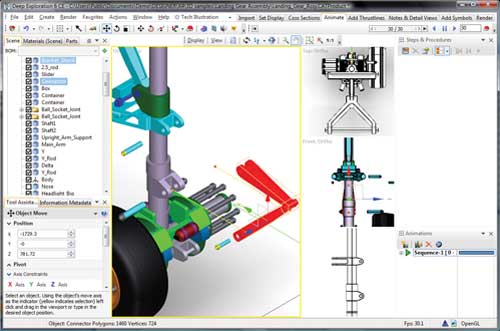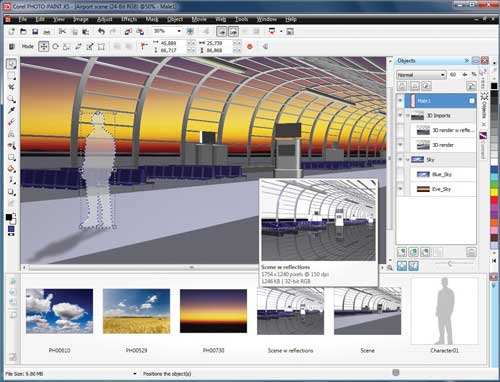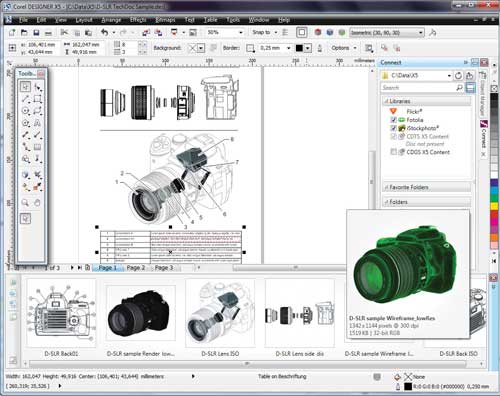Latest News
December 4, 2001
By David Cohn
The needs of engineering, marketing and technical publishing are quite different. Engineers require tools to help them design products so that they can be manufactured. Marketing needs pretty pictures for ads and brochures. And the tech pub folks often want simplified drawings for catalogs and manuals. It’s quite common for each team to create entirely new images from scratch “a disconnect that results in wasted effort and inaccuracies.
Corel Designer Technical Suite X5 aims to eliminate that disconnect. Users can start projects based on almost any source material “including numerous CAD formats, most vector and raster file types, or from scratch “to create illustrations, diagrams and technical documentation, and produce output for print or online distribution in an equally wide array of formats.

Integration with Right Hemisphere’s Deep Exploration CCE lets users open
CAD models, adjust parts as needed, and then send the results to Corel
Designer or Photo-Paint.
The Heart of the Suite
Central to the Designer Technical Suite is Corel Designer, the company’s specialized application for vector drawing, page layout and diagramming. In 2001, Corel acquired MicrographX; Corel Designer is the successor to that product. If you’ve ever worked with CorelDraw, the Designer interface will seem quite familiar.
The program provides a collection of tools to help users create technical illustrations. There are tools for creating and editing shapes, adding text and callouts, and so on. You can rotate objects into the desired orientation, add dimensions, insert tables for bills of materials, and add various artistic effects.

3D models exported in bitmap format can be refined and enhanced in Corel
Photo-Paint.
Although Designer is actually a 2D program, one of its most interesting capabilities is being able to draw on planes aligned to appear to be 3D. Once these planes are created, you can easily draw and place text so that it looks like it is part of a 3D object. The new X5 release features enhanced isometric drawing capabilities with improved gravity snapping and temporary dynamic guides that appear based on snap points to help users align, draw and move objects in relation to other objects. Users can now modify objects in isometric views and create persistent rounded corners. There’s also improved callout capabilities with automatic renumbering.
While an artist could certainly use the tools in Corel Designer to create new illustrations from scratch, a big part of the program’s power comes from its ability to open more than three dozen different file formats, including CAD drawings saved in AutoCAD DWG format, PDF files and native Adobe Photoshop and Illustrator files. Once open in Designer, you can use any of Designer’s tools to convert those assets into a finished technical illustration.
CAD Conversion Tool
But the Corel Designer Technical Suite X5 doesn’t stop there. The package also includes Right Hemisphere Deep Exploration CSE. With Deep Exploration CSE, you can open AutoCAD DWG files—as well as various other formats including 3DS Max, VRML, SketchUp and drawings produced in Creo (formerly Pro/ENGINEER) and CATIA.
Because most CAD programs can save files to one of the supported formats, CSE might be enough. But those who prefer to work with their native CAD formats can purchase Deep Exploration CCE (a $1,699 add-on), which adds support for more than 80 additional formats, including Inventor, SolidWorks and NX, as well as IGES, STEP and SAT.
Once any of the supported CAD files is open in Deep Exploration, you can apply cross-sections and exploded views. Deep Exploration includes dedicated workspaces for technical illustration, high dynamic range (HDR) rendering, training, and sales and marketing materials, so you can quickly achieve the desired look. While working in Deep Exploration, you can still see the entire part assembly tree and manipulate individual objects.
Once you’ve got the model displayed the way you want it in Deep Exploration, you can send vector data to Corel Designer or raster data to Corel Photo-Paint with a single click. If you send a rendered image to Photo-Paint, you can then use tools to create the desired effect, such as converting colors to grayscale, and then send the bitmap image to Designer or CorelDraw.
Although Deep Exploration is a standalone application, it is tightly integrated with Corel Designer. When working in Designer, selecting 3D Import automatically launches Deep Exploration so that you can open and prepare a 3D model. And in addition to the tools in Deep Exploration for quickly sending files to Designer or Photo-Paint, there are also batch conversion tools for converting or rendering files.
Lots in the Box
Since first introducing CorelDraw in 1989, Corel Corp. has long been known for its award-winning graphics software. The Ottawa-based company also has a reputation for bundling lots of different tools with each of its programs.
Nowhere is that more evident than in this latest Designer Technical Suite. The package includes nearly a dozen separate components. In addition to Designer, Photo-Paint and Deep Exploration CSE, Technical Suite X5 now includes a full copy of CorelDraw, the latest version of Corel PowerTrace for raster-to-vector conversion, the Corel CAPTURE screen capture utility, the SWiSH miniMax Flash animation software, the PhotoZoom Pro photo enlarger plug-in for Photo-Paint, Microsoft Visual Studio Tools for Applications (VSTA) and Microsoft Visual Basic for Applications (VBA). There’s also a wide assortment of fonts, photos and clip art. Our installation consumed more than 6.5GB of disc space.
The new Corel Connect application is a standalone content browser that helps users search for and preview content stored both locally and online, then quickly add that content to their designs. Once content has been located, you can place it into a tray at the bottom of the Connect window. You can then open the content in CorelDraw, Designer, Photo-Paint or in its native application (if available). You can also simply drag content from Connect and drop it into an active CorelDraw, Designer or Photo-Paint document.

Corel Connect can be used as a standalone program or as a docker in Corel
Designer, CorelDraw, and Corel Photo-Paint. Assets in the docker are
synchronized in all of the Technical Suite programs.
Among the new features and enhancements in the latest version of Designer is a new color management system. While the software includes presets for various standards, users can now adjust any setting and embed color profiles within saved documents to help ensure color fidelity throughout the production process.
The new X5 version of PowerTrace has been enhanced, and users report that it produces better raster-to-vector results than ever before. Designer’s overall performance is also improved, with support for multi-threading to take advantage of modern, multi-core processors.
Once you’ve completed your illustration, Technical Suite X5 provides lots of output options. Users can save to a wide assortment of formats, including PostScript Level 3, PDF, PDF/A, WebCGM, S1000D and Flash.
A Complete Suite
With all of the different applications included, Corel Designer Technical Suite X5 presents a bit of a learning curve. Of course, if you’ve used a Corel product before, you’ll likely catch on pretty quickly. For those who take the plunge, Corel Designer Technical Suite X5 delivers a very complete, cost-effective solution for your technical communication needs.
For More Information:
Corel DESIGNER Technical Suite X5
Price:
- Full copy: $999
- Upgrade: $499
- Right Hemisphere Deep Exploration CCE Add-on: $1,699
System Requirements:
- Operating System: Windows 7, Windows Vista (SP2 or later), or Windows XP (SP3 or later); 64-bit or 32-bit
- CPU: Intel Pentium 4, AMD Athlon 64, or AMD Opteron 1GHz or greater (2GHz or greater recommended)
- Memory: 1GB RAM (3GB recommended, more for 64-bit Windows)
- Disk Space: 1.4GB free disk space for installation (1.6GB for typical installation without content; up to 6.7GB needed to install extra content)
- Video: 1024x768 VGA, Microsoft DirectX v9 (3D hardware accelerated graphics card with 256MB of RAM, OpenGL 2.0 and Shader Model 3.0; support for HDR rendering.
David Cohn is the technical publishing manager at 4D Technologies. He’s a contributing editor to Desktop Engineering and also does consulting and technical writing from his home in Bellingham, WA. The author of more than a dozen books has been benchmarking PCs since 1984. You can contact him via email at [email protected] or visit DSCohn.com.
Subscribe to our FREE magazine, FREE email newsletters or both!
Latest News
About the Author
David Cohn is a consultant and technical writer based in Bellingham, WA, and has been benchmarking PCs since 1984. He is a Contributing Editor to Digital Engineering, the former senior content manager at 4D Technologies, and the author of more than a dozen books. Email at [email protected] or visit his website at www.dscohn.com.
Follow DE





